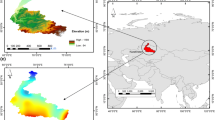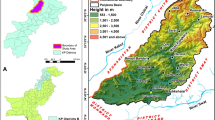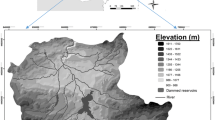Abstract
This research attempted to evaluate the soil loss-prone zones and affecting key factors in a suburb agricultural area in the western Mashhad city, northeastern Iran, using the universal soil loss equation model. All erosion factors and components were produced in GIS grid-based modeling. Therefore, the required data, such as topography, climate, and soil characteristics, were collected from global databases. The estimated annual soil loss values were classified into five classes from slight soil losses (0–3 t ha−1 year−1) at the plain lowland in the northern region to severe soil losses (25–55 t ha−1 year−1) at the hillsides and terraces in the middle part of the study area. The results revealed that about 9.36% of the study area (6743 km2) is under critical erosion-prone zones of high and severe soil losses (over 15 t ha−1 year−1). Ultimately, the relationships between soil loss-prone zones and soil taxonomy order/sub-orders were investigated to prevalence the results in the other alike geo-climatic status. Correlation analysis conveniently confirmed a very strong, significant, and direct relationship (R equal to 0.997) between high/severe soil losses and xerolls in the study area at the 95% confidence level. In the study area, the most soil loss and sedimentation were predicted for xerolls soil sub-order (mollisols) with 5.5 t ha−1 year−1 and 14.69 million t year−1 (over 60% of total sedimentations).









Similar content being viewed by others
Availability of data and material
The data that support the findings of this study are available from the corresponding author upon request.
References
Adinarayana J, Rao KG, Krishna NR, Venkatachalam P, Suri JK (1999) A rule-based soil erosion model for Ahilly catchment. CATENA 37:309–318
Auerswald K, Fiener P, Martin W, Elhaus D (2014) Use and misuse of the K factor equation in soil erosion modeling: analternative equation for determining USLE nomograph soilerodibility values. CATENA 118:220–225
Baban SMJ, Yusof KW (2001) Modelling soil erosion in tropical environments using remote sensing and geographical information systems. Hydrol Sci J 46(2):191–198
Bagarello V, Stefano CD, Ferro V, Giordano G, Iovino M, Pampalone V (2012) Estimating the USLE soil erodibility factor in Sicily, south Italy. Appl Eng Agric 28:199–206
Bagherzadeh A (2014) Estimation of soil losses by USLE model using GIS at Mashhad plain, Northeast of Iran. Arab J Geosci 7:211–220
Bagherzadeh A, Daneshvar MRM (2013a) Mapping of landslide hazard zonation using GIS at Golestan watershed, northeast of Iran. Arab J Geosci 6:3377–3388
Bagherzadeh A, Daneshvar MRM (2013b) Evaluation of sediment yield and soil loss by the MPSIAC model using GIS at Golestan watershed, northeast of Iran. Arab J Geosci 6:3349–3362
Bagherzadeh A, Daneshvar MRM (2014) Qualitative land suitability evaluation for wheat and barley crops in Khorasan-Razavi province, northeast of Iran. Agric Res 3(2):155–164
Bahadur KCK (2009) Mapping soil erosion susceptibility using remote sensing and gis: a case of the upper name Wa watershed, Nan province, Thailand. Environ Geol 57(3):695–705
Bartsch KP, van Miegroet H, Boettinger J, Dobrwolski JP (2002) Using empirical erosion models and GIS to determine erosion risk at Camp Williams. J Soil Water Conserv 57:29–37
Baskan O, Cebel H, Akgul S, Erpul G (2010) Conditional simulation of USLE/RUSLE soil erodibility factor by geostatistics in a Mediterranean Catchment, Turkey. Environ Earth Sci 60(6):1179–1187
Bhattarai R, Dutta D (2007) Estimation of soil erosion and sediment yield using gis at catchment scale. Water Resour Manage 21(10):1635–1647
Bikdeli S (2019) Redevelopment modeling for land suitability evaluation of the suburb brown-fields using fuzzy logic and GIS, northeastern Iran. Environ Dev Sustain:1–20
Bryan RB, Govers G, Poesenb SRA (1989) The concept of soil erodibility and some problems of assessment and application. CATENA 16:393–412
Cerri CEP, Dematte JAM, Ballester MVR, Martinelli LA, Victoria RL, Roose E (2001) GIS erosion risk assessment of the Piracicaba River Basin, southeastern Brazil. Mapp Sci Remote Sens 38:157–171
Chen T, Niu RQ, Li PX, Zhang LP, Du B (2011) Regional soil erosion risk mapping using RUSLE, GIS, and remote sensing: a case study in Miyun Watershed, North China. Environ Earth Sci 63(3):533–541
Daneshvar MRM, Bagherzadeh A (2011) Landslide hazard zonation assessment using GIS analysis at Golmakan watershed, northeast of Iran. Front Earth Sci 5(1):70–81
Daneshvar MRM, Bagherzadeh A (2012) Evaluation of sediment yield in PSIAC and MPSIAC models by using GIS at Toroq watershed, northeast of Iran. Front Earth Sci 6(1):83–94
Daneshvar MRM, Rabbani G, Shirvani S (2019) Assessment of urban sprawl effects on regional climate change using a hybrid model of factor analysis and analytical network process in the Mashhad city, Iran. Environ Syst Res 8:23
Dumas P, Printemps J (2010) Assessment of soil erosion using USLE Model and GIS for integrated watershed and coastal zone management in the South Pacific Islands. In: Proceedings of international symposium in Pacific Rim, pp 856–866
Erdogan EH, Erpul G, Bayramin I (2007) Use of USLE/GIS methodology for predicting soil loss in a semiarid agricultural watershed. Environ Monit Assess 131:153–161
Ferreira V, Panagopoulos T, Andrade R, Guerrero C, Loures L (2015) Spatial variability of soil properties and soil erodibility in the Alqueva reservoir watershed. Solid Earth 6:383–392
Fistikoglu O, Harmancioglu NB (2002) Integration of GIS with USLE in assessment of soil erosion. Water Resour Manag 16:447–467
Foster GR (2005) Draft: science documentation, revised universal soil loss equation version 2 (RUSLE2). USDA-Agricultural Research Service, Washington, D.C.
FRWM (2015) Land use and land cover shape-files at scale 1:200,000 archived by forests, range and watershed management organization of Iran. http://www.frw.org.ir. Accessed 2018
Fu BJ, Zhao WW, Chen LD (2005) Assessment of soil erosion at large watershed scale using RUSLE and GIS a case study in the loess plateau of China. Land Degrad Dev 16:73–85
GSI (2018) Geological sheets at scale 1:100,000, sheet of 7862 (Torqabeh), archived by the geological survey of Iran. http://www.gsi.ir. Accessed 2018
Gu S, Cheng XL, Shen ZH, Zhang QF (2007) Land use, land cover and soil erosion in the upper reaches of Han River basin. Resour Environ Yangtze Basin 16:38–44
Guo M, Jian J, Zhao Z, Jiao J (2013) Measurement on physical parameters of raindrop energy. Springerplus 2(Suppl 1):S16
Hengl T, Mendes de Jesus J, MacMillan RA, Batjes NH, Heuvelink GBM, Ribeiro E, Samuel-Rosa A, Kempe B, Leenaars JGB, Walsh MG, Gonzalez MR (2014) SoilGrids1km—global soil information based on automated mapping. PLoS ONE 9(8):e105992
Hijmans RJ, Cameron SE, Parra JL, Jones PG, Jarvis A (2005) Very High Resolution Interpolated Climate Surfaces for Global Land Areas. Int J Climatol 25(15):1965–1978
Hui L, Xiaoling C, Lim KJ, Xiaobin C, Sagong M (2010) Assessment of Soil erosion and sediment yield in Liao watershed, Jiangxi province, China, using USLE, GIS, and RS. J Earth Sci 21(6):941–953
Igwe CA (2003) Erodibility of soils of the upper rainforest zone, southeastern Nigeria. Land Degrad Dev 14:323–334
Jain MK, Kothyari UC (2000) Estimation of soil erosion and sediment yield using GIS. Hydrol Sci J 45(5):771–786
Jain SK, Kumar S, Varghese J (2001) Estimation of soil erosion for a Himalayan watershed using GIS technique. Water Resour Manag 15:41–54
Lee S (2004) Soil erosion assessment and its verification using the universal soil loss equation and geographic information system: a case study at boun, Korea. Environ Geol 45(4):457–465
Lu D, Li G, Valladares GS, Batistella M (2004) Mapping Soil Erosion Risk in Rondonia, Brazilian Amazonia: using RUSLE, remote sensing and GIS. Land Degrad Dev 15(5):499–512
Mati BM, Morgan RPC, Gichuki FN, Quinton JN, Brewer TR, Liniger HP (2000) Assessment of erosion hazard with the USLE and GIS: a case study of the upper Ewaso Ng’iro North Basin of Kenya. J Appl Earth Observ Geoinf 2(2):78–86
McCool DK, Foster GR, Mutchler CK, Meyer LD (1987) Revised slope steepness factor for the universal Soil Loss Equation. Trans ASAE 30(5):1387–1396
Meusburger K, Alewell C (2009) On the influence of temporal change on the validity of landslide susceptibility maps. Nat Hazards Earth Syst Sci 9:1495–1507
Meusburger K, Konz N, Schaub M, Alewell C (2009) Soil erosion modelled with USLE and PESERA using QuickBird derived vegetation parameters in an alpine catchment. Int J Appl Earth Obs Geoinf 12:208–215
Mhangara P, Kakembo V, Lim KJ (2012) Soil erosion risk assessment of the Keiskamma Catchment, South Africa using GIS and remote sensing. Environ Earth Sci 65(7):2087–2102
Millward AA, Mersey JE (1999) Adapting the RUSLE to model soil erosion potential in a mountainous tropical watershed. CATENA 38(2):109–129
Morgan RPC, Davidson DA (1991) Soil erosion and conservation. Longman Group, UK
NASA (2011) The ASTER global digital elevation model (GDEM) archived by National aeronautics and space administration (NASA). Earth remote sensing data analysis center. http://www.gdem.aster.ersdac.or.jp/search.jsp. Accessed 2018
Nearing MA, Foster GR, Lane LJ, Finkner SC (1989) A process based soil erosion model for USDA-Water Erosion Prediction Project Technology. Trans ASAE 32:1587–1593
Ozcan AU, Erpul G, Basaran M, Erdogan HE (2008) Use of USLE/GIS technology integrated with geostatistics to assess soil erosion risk in different land uses of Indagi Mountain Pass—Cankiri, Turkey. Environ Geol 53(8):1731–1741
Pandey A, Chowdary VM, Mal BC (2007) Identification of critical erosion prone areas in the small agricultural watershed using USLE, GIS and remote sensing. Water Resour Manag 21:729–746
Parveen R, Kumar U (2012) Integrated approach of universal soil loss equation (USLE) and geographical information system (GIS) for soil loss risk assessment in upper south Koel basin, Jharkhand. J Geogr Inf Syst 4:588–596
Perović V, Zivotic L, Kadovic R, Dordevic A (2013) Spatial modelling of soil erosion potential in a mountainous watershed of South-eastern Serbia. Environ Earth Sci 68(1):115–128
Rabbani G, Shafaqi S, Rahnama MR (2017) Urban sprawl modeling using statistical approach in Mashhad, northeastern Iran. Model Earth Syst Environ 4(1):141–149
Rahman MR, Shi ZH, Cai CF (2009) Soil erosion hazard evaluation—An integrated use of remote sensing, GIS and statistical approaches with biophysical parameters towards management strategies. Ecol Model 220:1724–1734
Rao YP (1981) Evaluation of cropping management factor in universal soil Loss equation under natural rainfall condition of Kharagpur, India. In: Proceedings of Southeast Asian regional symposium on problems of soil erosion and sedimentation. Asian Institute of Tedchnology, Bangkok, pp 241–254
Renard KG, Foster GR, Weesies GA, McCool DK, Yoder DC (1997) Predicting soil erosion by water: a guide to conservation. Planning with the revised universal soil loss equation (RUSLE). Agric. Handbook, 703. U.S. Department of Agriculture, Washington, D.C
Shen DY, Ma AN, Lin H, Nie XH, Mao SJ, Zhang B, Shi JJ (2003) A new approach for simulating water erosion on hill slopes. Int J Remote Sens 24:2819–2835
Shi ZH, Cai CF, Ding SW, Wang TW, Chow TL (2004) Soil conservation planning at the small watershed level using RUSLE with GIS: a case study in the three gorges area of China. CATENA 55(1):33–48
Sinha D, Joshi VU (2012) Application of universal soil loss equation (USLE) to recently reclaimed badlands along the adula and mahalungi rivers, Pravara Basin, Maharashtra. J Geol Soc India 80:341–350
USDA (1999) Soil taxonomy a basic system of soil classification for making and interpreting soil surveys, 2nd edition. Soil Survey Staff, United States Department of Agriculture. Agriculture Handbook, No. 436
Wang G, Gertner G, Fang S, Anderson AB (2003) Mapping multiple variables for predicting soil loss by geostatistical methods with TM images and a slope map. Photogramm Eng Remote Sens 69:889–898
Wischmeier WH, Smith DD (1978) Predicting rainfall erosion losses: a guide to conservation planning. Agriculture Handbook No. 537, US Department of Agriculture, Washington, DC
Zhao W, Wei H, Jia L, Daryanto S, Zhang X, Liu Y (2018) Soil erodibility and its influencing factors on the Loess Plateau of China: a case study in the Ansai watershed. Solid Earth 9:1507–1516
Zhu M (2015) Soil erosion assessment using USLE in the GIS environment: a case study in the Danjiangkou Reservoir Region, China. Environ Earth Sci 73(12):7899–7908
Acknowledgements
We thank two anonymous reviewers for their essential comments and technical suggestions on data interpretations. Also, we are grateful to dear managing editor for precious consideration of the manuscript.
Funding
This study was not funded by any grant.
Author information
Authors and Affiliations
Contributions
All authors were equally involved in analyzing and editing the paper.
Corresponding author
Ethics declarations
Conflict of interest
The authors declare that they have no conflict of interest.
Ethics approval
This article does not contain any studies with participants performed by any of the authors.
Informed consent
Informed consent was obtained from individual participant included in the study.
Rights and permissions
About this article
Cite this article
Ebrahimi, M., Nejadsoleymani, H., Sadeghi, A. et al. Assessment of the soil loss-prone zones using the USLE model in northeastern Iran. Paddy Water Environ 19, 71–86 (2021). https://doi.org/10.1007/s10333-020-00820-9
Received:
Revised:
Accepted:
Published:
Issue Date:
DOI: https://doi.org/10.1007/s10333-020-00820-9




